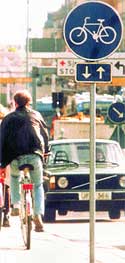Sans car, sans crisis
 The movement to make cities car-free is gaining momentum (see: Down To Earth, July 15, 2001). The city of Freiburg in Germany has shown that it is indeed possible to virtually stop the growth of car use, even when car ownership is rising. Freiburg's car ownership rose from 113 cars per 1,000 people in 1960 to 422 per 1,000 in 1990. However, daily auto use remained constant between 1976 and 1991. Transit passengers increased by 53 per cent and bicycle trips rose 96 per cent over the same period. While total trips increased 30 per cent, car trips increased just 1.3 per cent over 15 years. In fact, share of trips by cars fell 60 per cent. Frieburg achieved this through mechanisms such as pedestrianisation of the city centre, traffic calming programmes, and a difficult, expensive parking to discourage car use. The city combined these measures with improvements in its transit facilities, such as extension and upgradation of its light rail system and the use of buses as feeders.
The movement to make cities car-free is gaining momentum (see: Down To Earth, July 15, 2001). The city of Freiburg in Germany has shown that it is indeed possible to virtually stop the growth of car use, even when car ownership is rising. Freiburg's car ownership rose from 113 cars per 1,000 people in 1960 to 422 per 1,000 in 1990. However, daily auto use remained constant between 1976 and 1991. Transit passengers increased by 53 per cent and bicycle trips rose 96 per cent over the same period. While total trips increased 30 per cent, car trips increased just 1.3 per cent over 15 years. In fact, share of trips by cars fell 60 per cent. Frieburg achieved this through mechanisms such as pedestrianisation of the city centre, traffic calming programmes, and a difficult, expensive parking to discourage car use. The city combined these measures with improvements in its transit facilities, such as extension and upgradation of its light rail system and the use of buses as feeders.
Examples of cities like Frieburg abound. Strasbourg (France) has provided its citizens with a 300-km network of bicycle routes. Bogota (Columbia), Singapore and Hong Kong have made efforts to encourage walking and cycling as options. In Germany, public policies have been largely responsible for creating a suburban environment where bicycling remains a feasible travel option. Shanghai in China
